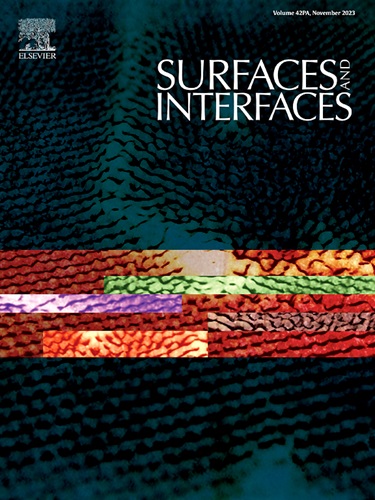Garlic (Allium sativum) extract mediated synthesis of self-redox SnO2 nanomaterials for reduction of Cr(VI) under dark condition
IF 5.7
2区 材料科学
Q2 CHEMISTRY, PHYSICAL
引用次数: 0
Abstract
Hexavalent chromium [Cr(VI)] is a highly toxic heavy metal mainly released from various industrial processes. Its high-water solubility allows to readily enter the human body and posing serious health risks. Therefore, its remediation through catalytic reduction is an essential and effective treatment strategy. In this study, a green technology approach was employed to synthesize SnO₂ catalyst nanomaterials, with varied properties, for the reduction of Cr(VI) under dark condition. Various ratios of the two tin precursors, SnCl₂·2H₂O and SnCl₄·5H₂O, were used to modulate the catalyst characteristics. An extract from fresh garlic (Allium sativum) served as an efficient nucleating and precipitating agent for the formation of SnO₂ nanoparticles. The electronic properties, morphologies, crystal phases, and chemical states of the resulting SnO2 nanomaterials were characterized. The SnO2 nanocatalyst synthesized from SnCl₂·2H₂O (Sn-2) demonstrated 100 % Cr(VI) reduction efficiency within 14 min with a rate constant 68 times higher than SnO2 derived from SnCl4·5H₂O (Sn-4), which itself showed only 5.6 % reduction activity. Remarkably, combining equal weight ratios of both precursors to produce SnO2 catalyst enhanced the Cr(VI) reduction to 100 % within 10 min. The presence of point defects and self-redox interactions between Sn2+ and Sn4+ in SnO2 played pivotal roles for the reduction of Cr(VI) under dark conditions. Taken together, the green synthesized SnO₂ nanomaterials could offer significant potential for environmental remediations and public health protection.
在黑暗条件下,大蒜提取物介导合成自氧化还原SnO2纳米材料还原Cr(VI)
六价铬[Cr(VI)]是一种主要从各种工业过程中释放的剧毒重金属。其高水溶性允许容易进入人体,并构成严重的健康风险。因此,通过催化还原对其进行修复是一种必要而有效的处理策略。本研究采用绿色技术方法,在黑暗条件下合成了不同性能的SnO₂催化剂纳米材料,用于还原Cr(VI)。采用不同比例的SnCl₂·2H₂O和SnCl₄·5H₂O两种锡前驱物来调节催化剂的性能。新鲜大蒜(Allium sativum)的提取物是一种有效的成核和沉淀剂,用于形成SnO₂纳米颗粒。对所得SnO2纳米材料的电子性能、形貌、晶相和化学状态进行了表征。由SnCl4·2H₂O (Sn-2)合成的SnO2纳米催化剂在14 min内具有100%的Cr(VI)还原效率,其还原速率是由SnCl4·5H₂O (Sn-4)合成的SnO2纳米催化剂的68倍,而SnCl4·5H₂O (Sn-4)的还原活性仅为5.6%。值得注意的是,将两种前驱体的重量比相同的情况下合成SnO2催化剂,可以在10分钟内将Cr(VI)还原到100%。SnO2中点缺陷的存在以及Sn2+和Sn4+之间的自氧化还原相互作用对黑暗条件下Cr(VI)的还原起关键作用。综上所述,绿色合成的二氧化氮纳米材料在环境修复和公众健康保护方面具有巨大的潜力。
本文章由计算机程序翻译,如有差异,请以英文原文为准。
求助全文
约1分钟内获得全文
求助全文
来源期刊

Surfaces and Interfaces
Chemistry-General Chemistry
CiteScore
8.50
自引率
6.50%
发文量
753
审稿时长
35 days
期刊介绍:
The aim of the journal is to provide a respectful outlet for ''sound science'' papers in all research areas on surfaces and interfaces. We define sound science papers as papers that describe new and well-executed research, but that do not necessarily provide brand new insights or are merely a description of research results.
Surfaces and Interfaces publishes research papers in all fields of surface science which may not always find the right home on first submission to our Elsevier sister journals (Applied Surface, Surface and Coatings Technology, Thin Solid Films)
 求助内容:
求助内容: 应助结果提醒方式:
应助结果提醒方式:


